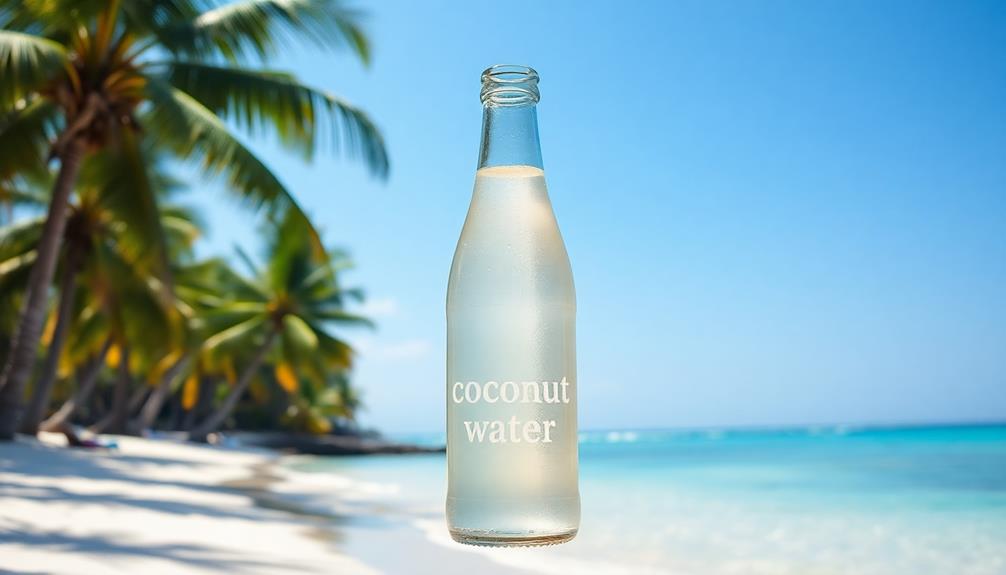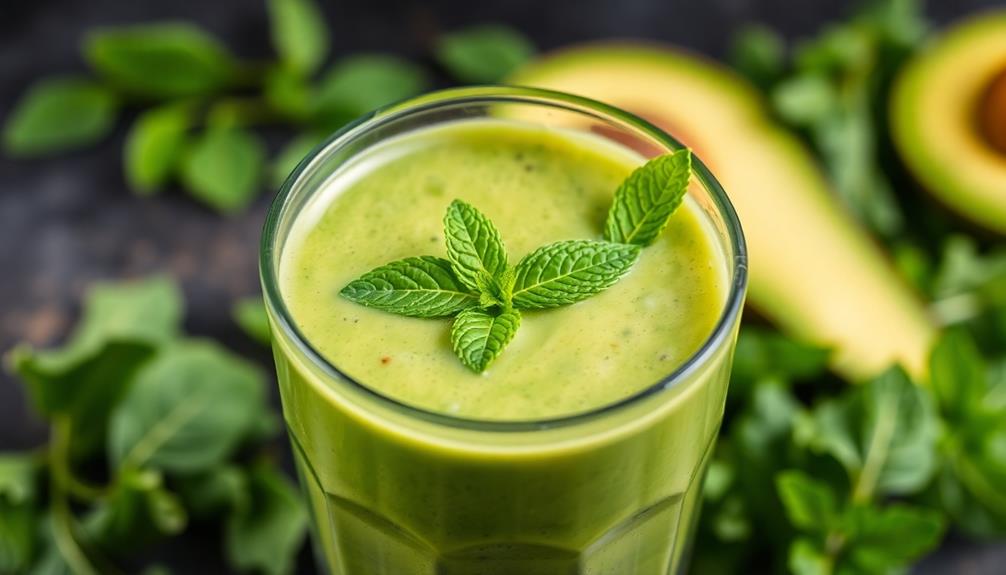Coconut water elixir – what a refreshing treat! This tropical drink's history stretches back centuries, as ancient cultures celebrated its rejuvenating powers. Not only does it taste incredible, but coconut water is packed with electrolytes, potassium, and natural sugars to keep you hydrated and energized. To make your own, simply simmer fresh coconut water with raw honey, lime juice, ginger, and vanilla. Sip this chilled concoction straight or use it as a mixer for smoothies and cocktails. You'll love how its subtle coconut notes and tingly sensation quench your thirst. Intrigued? Keep reading to discover more tasty ways to enjoy this island-inspired elixir.
Key Takeaways
- Coconut water elixir is a refreshing and hydrating beverage made by simmering coconut water with raw honey, lime juice, ginger, and vanilla extract.
- The elixir is rich in natural electrolytes, low in calories, and free from artificial additives, making it a healthy alternative to sugary drinks.
- Coconut water has been consumed for thousands of years in various cultures for its rejuvenating properties and impressive nutritional profile.
- The elixir can be enjoyed chilled or used as a base for smoothies, cocktails, and other recipes, offering a tropical twist.
- Coconut water elixir is versatile and suitable for various dietary preferences, being naturally gluten-free and vegan.
History

Coconut water has, for centuries, captivated the imagination of cultures across the globe. This refreshing, natural elixir has been revered for its unique flavor and impressive health benefits, much like various herbal teas known for their soothing properties. From the tropical islands of the Pacific to the bustling cities of Asia, coconut water has long been celebrated as a symbol of vitality and rejuvenation.
Herbal teas offer health benefits such as aiding digestion and promoting relaxation, paralleling the nourishing qualities of coconut water.
Archaeologists have discovered evidence that ancient civilizations, like the Polynesians and Filipinos, have been enjoying the delights of coconut water for thousands of years. These early communities recognized the versatility of this versatile liquid, using it not only as a thirst-quenching beverage but also in traditional medicine and religious rituals.
As the world has become more interconnected, coconut water's popularity has soared, with people around the globe embracing its refreshing taste and remarkable nutritional profile.
Today, this remarkable elixir continues to captivate the hearts and palates of people everywhere, standing as a testament to the timeless allure of nature's most remarkable offerings.
Recipe

Coconut water is a refreshing and hydrating beverage that has gained immense popularity in recent years. Its natural electrolyte content and potential health benefits make it an excellent choice for those seeking a healthier alternative to sugary drinks.
Additionally, incorporating essential oils into your wellness routine can complement the benefits of coconut water, as they're known for their ability to promote relaxation and emotional well-being through Aromatherapy benefits. In this recipe, we'll show you how to create a delightful coconut water elixir that can be enjoyed on its own or used as a base for various cocktails and mocktails.
Coconut water's versatility extends beyond its refreshing qualities. It can also be used in cooking, adding a subtle sweetness and tropical flair to both savory and sweet dishes. This recipe for a coconut water elixir showcases the versatility of this remarkable ingredient.
Ingredients:
- 4 cups of fresh coconut water
- 1/4 cup of raw honey
- 1 tablespoon of freshly squeezed lime juice
- 1 inch of fresh ginger, peeled and grated
- 1 teaspoon of vanilla extract
- Pinch of sea salt
In a medium saucepan, combine the coconut water, honey, lime juice, grated ginger, and vanilla extract. Bring the mixture to a gentle simmer over medium heat, stirring occasionally until the honey has completely dissolved.
Remove from heat and allow to cool slightly. Once cooled, stir in the pinch of sea salt.
To enjoy the coconut water elixir, simply pour it over ice in a glass. You can also use it as a base for cocktails or mocktails, adding your desired spirits, juices, or garnishes.
The elixir can be stored in an airtight container in the refrigerator for up to 5 days, making it a convenient and refreshing option any time.
Cooking Steps

Crack open that coconut and let the water flow! The refreshing taste of coconut water isn't only delicious but also packed with electrolytes, making it a great hydration option.
Strain it through some cheesecloth to get it nice and smooth. A squeeze of lemon juice'll give it a tasty zing, and you might want to consider how currency fluctuations can affect the cost of importing coconuts if you're buying from overseas.
Pop it in the fridge to chill, then grab a glass and enjoy your refreshing coconut water elixir!
Step 1. Crack Open Coconut, Extract Water

Typically, the first step in extracting the refreshing liquid from a coconut is to crack it open. You'll need a sturdy knife or a coconut opener tool to get the job done.
Carefully place the coconut on a steady surface and strike it firmly against the blade to split the tough shell in half. Don't be discouraged if it takes a few tries – coconuts can be quite stubborn!
Once the coconut is cracked, you can easily pry it open and reveal the clear, slightly sweet water inside.
Carefully tilt the halves over a glass or bowl to let the liquid pour out. You might even see a bit of soft, gelatinous coconut meat floating in the water – that's a delicious bonus!
Strain the water through a mesh sieve if you prefer a perfectly clear drink.
Now you can enjoy the refreshing, electrolyte-rich coconut water straight away or use it in all sorts of tasty recipes.
Step 2. Strain Coconut Water Through Cheesecloth

Once you've extracted the coconut water, it's a good idea to strain it through a layer of cheesecloth.
This helps remove any small bits of coconut flesh or other impurities that might've made their way into the liquid.
Simply place the cheesecloth over a clean bowl or pitcher, then slowly pour the coconut water through.
The cheesecloth will catch those pesky little bits, leaving you with a nice, clear and pure coconut water.
You can even give the cheesecloth a gentle squeeze to extract every last drop.
Now you've got yourself some super fresh and healthy coconut water, ready to enjoy as is or use in your favorite recipes.
It's a simple extra step, but it's worth it to ensure your coconut water is as pure and delicious as can be.
Cheers to that refreshing, tropical taste!
Step 3. Add Lemon Juice for Flavor

After straining the coconut water, you can add a hint of lemon juice to enhance the flavor. A squeeze or two of fresh lemon will help brighten up the natural sweetness of the coconut water, creating a refreshing and zesty treat.
The citrusy notes from the lemon perfectly complement the tropical coconut flavor, making it even more thirst-quenching. You can start with just a teaspoon of lemon juice and give it a taste, then add more if you'd like an even tangier kick.
Be careful not to overdo it, though – you still want the lovely coconut taste to shine through. The lemon juice also helps to balance the natural electrolytes in the coconut water, so you'll be sipping on a wonderfully hydrating and flavorful elixir.
Give it a try and see how you like the delightful combination of coconut and lemon!
Step 4. Refrigerate Before Serving Chilled

For the best flavor and refreshment, refrigerate the coconut water before serving. When you chill the coconut water, it gets nice and cold, which makes it even more thirst-quenching and delightful to drink.
Stick the bottle or carton in the fridge for at least 30 minutes – an hour is even better. This gives the coconut water time to cool down to a refreshing temperature.
Once it's nicely chilled, you can pour the coconut water over ice for an extra icy treat. The cold temperature brings out the naturally sweet and slightly nutty flavor of the coconut.
It's so refreshing and hydrating, perfect for a hot day! You can even add a squeeze of fresh lemon juice to give it a little zing. The lemon and coconut flavors complement each other beautifully.
Sip and enjoy your perfectly chilled coconut water elixir. It's sure to quench your thirst and leave you feeling revived.
Step 5. Enjoy the Chilled Coconut Water Elixir

Grab your chilled coconut water and get ready to enjoy its refreshing elixir! The cool, creamy liquid is bursting with natural sweetness and electrolytes that'll rehydrate and revitalize you.
Lift the bottle to your lips and take a refreshing sip. Ahh, feel that tingly sensation as the coconut water quenches your thirst?
Now, let the flavors dance on your tongue. Notice the subtle notes of coconut and the slight tanginess that adds a delightful complexity. This isn't your average boring water – it's a tropical treat that'll transport your taste buds to a breezy island oasis.
Go ahead, indulge in the whole bottle if you'd like. The natural sugars and nutrients will give you an energizing boost without the crash of sugary sports drinks.
Feel free to add a slice of lime or a sprig of mint to amplify the refreshing flavors even more. Sip, savor, and soak up the sunshine – this coconut water elixir is your ticket to a truly delightful experience!
Final Thoughts

While coconut water may not be a cure-all elixir, it's a refreshing and hydrating beverage that can provide a range of potential health benefits. You can enjoy it chilled on a hot day, or use it as a mixer in smoothies and cocktails.
The natural electrolytes in coconut water may help replenish what you lose through sweat, making it a great choice for athletes or anyone who's been active.
Ultimately, coconut water is a tasty and versatile drink that can be a fun and healthy addition to your daily routine.
Whether you're sipping it straight or getting creative in the kitchen, don't be afraid to experiment and find new ways to incorporate this tropical elixir into your life. Your taste buds and your body just might thank you for it!
Frequently Asked Questions
Is Coconut Water Elixir Suitable for People With Lactose Intolerance?
Yes, coconut water is suitable for people with lactose intolerance. It's a dairy-free, plant-based beverage that won't trigger any lactose-related issues. You can enjoy coconut water without worrying about any digestive discomfort.
How Long Can I Store the Homemade Coconut Water Elixir?
You can store your homemade coconut water elixir for up to 5 days in the refrigerator. Make sure to keep it in an airtight container to maintain its freshness and flavor.
Can I Use Coconut Water Elixir as a Natural Sweetener?
You can definitely use the coconut water elixir as a natural sweetener. It's a great alternative to refined sugars and provides some additional health benefits too. Just be mindful of the amount you use as it does contain natural sugars.
Does Coconut Water Elixir Have Any Side Effects?
While coconut water elixir is generally safe, it's always wise to consult your healthcare provider before using it, as some individuals may experience minor side effects like digestive discomfort or allergic reactions. It's important to be aware of your body's unique needs.
Can I Substitute Fresh Coconut Water With Packaged Coconut Water?
You can substitute fresh coconut water with packaged coconut water, but the nutrient content may be slightly lower in the packaged version. The taste and hydration benefits, however, are generally comparable.

















